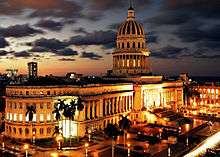Cuban Academy of Sciences
Coordinates: 23°08′07″N 82°21′35″W / 23.135249°N 82.359652°W

The Cuban Academy of Sciences (Academia de Ciencias de Cuba) is Cuba's Academy of Sciences,[1] with headquarters in the National Capitol building in Havana. It is described as the oldest active national academy of sciences outside Europe. The Academy is an official institution of the Cuban state with a national scope, independent and consultative in the area of science, and the successor of the former Royal Academy of Medicine, Physical and Natural Sciences of Havana, and is also attached to the Ministry of Science, Technology and the Environment.
The Academy represents the following fields: Agrarian and Fisheries Sciences, Biomedical Sciences, Exact and Natural Sciences, Social Sciences and Humanities, and Technical Sciences. Its members are nominated by scientific research institutions, universities, scientific societies as well as various other national organizations.
History
Cuba's first Academy of Sciences was founded by decree of Queen Isabella II of Spain on May 19, 1861, as the Royal Academy of Medical, Physical and Natural Sciences of Havana. Its original headquarters now houses the Carlos J. Finlay Historical Museum of Sciences.[2] In 1902 with the establishment of the Republic of Cuba, the word Royal was dropped from its title. In 1962 the Cuban government created the National Commission for the Academy of Sciences of Cuba, and in 1976 the Academy of Sciences of Cuba was established as a National Institute. In 1980 the Academy acquired the rank of a Ministry, encompassing all of the country's scientific and technological activity. In April 1996 it was established in its present form with a mission as follows: "to foster Cuban science, to disseminate national and universal scientific progress, to recognize the scientific research of excellence in the country, to raise ethic professional standards and social recognition of science, and to strengthen links between scientists and their organizations, both among themselves, with society at large, and with the rest of the world."
Over the last few decades, the Cuban Academy has worked with the U.S. Smithsonian Institution on scientific exchanges despite frayed political relations between the two nations.[3]
Awards
The Cuban Academy of Sciences presents the following awards:
- Award of the Academy of Sciences of Cuba
- Award of the Third Word Academy of Sciences for Cuban Scientific Youth (TWAS).
- National Award of Critics
- National Award of Social Sciences
- Scientific Book Award
References
- ↑ "Cuba, Academia de Ciencias de Cuba". International Council for Science (ICSU).
- ↑ "The Carlos J. Finlay Historical Museum of Sciences". USA Cuba Travel.
- ↑ Pastrana, Sergio Jorge. "Building a Lasting Cuba-U.S. Bridge through Science". Science & Diplomacy. Science & Diplomacy.
Further reading
- "Cuba: Academia de Ciencias Medicas, Fisicas y Naturales de la Habana". Handbook of Learned Societies and Institutions: America. USA: Carnegie Institution of Washington. 1908 – via HathiTrust.
External links
- Academia de Ciencias de Cuba
- Pruna, Pedro M. (September 1994). "National Science in a Colonial Context: The Royal Academy of Sciences of Havana, 1861-1898". Isis. University of Chicago Press. 85 (3): 412–426. doi:10.1086/356890. JSTOR 235461.